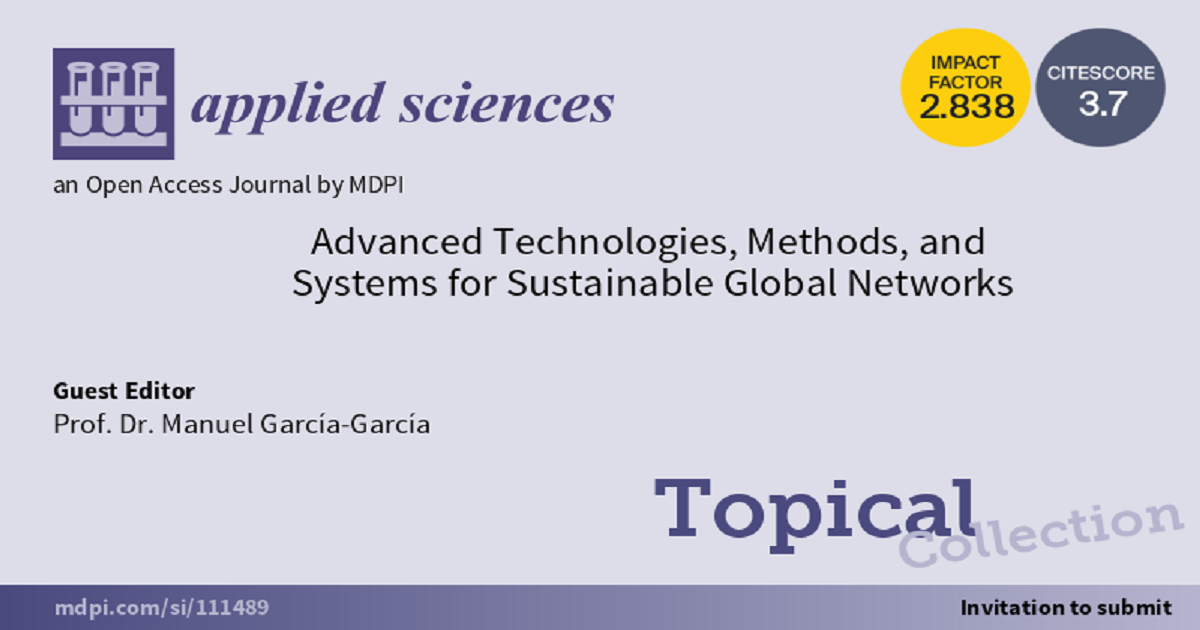Advanced Technologies, Methods, and Systems for Sustainable Global Networks
A topical collection in Applied Sciences (ISSN 2076-3417). This collection belongs to the section "Applied Industrial Technologies".
Viewed by 3063
Editor
Interests: ergonomics; workplace design; industrial engineering; manufacturing processes; maintenance management; strategic management; manufacturing technologies; Industry 4.0, corporate social responsibility; operations; industrial heritage
Special Issues, Collections and Topics in MDPI journals
Topical Collection Information
Dear Colleagues,
Over the history of evolution, the satisfaction of needs has had varied responses, although there has always been a pattern: the possibilities, technologies, and capabilities to meet them have increased. However, the world of the 21st century is one in which the basic needs of millions of human beings are still not satisfied. Therefore, the current global market situation pursues high adaptability as globalization makes disruptions a major risk for operations in the existing global networks. Disruptions such as disasters, epidemic crises, product changes, and socio-economic situations lead to significant global consequences for organizations, society, and individuals if they are not managed properly with suitable methods and supporting technologies. Therefore, there is an urgent need, with regard to both research and the real world, to develop technological solutions to improve the management of industrial and service companies to increase their adaptability to face any potential future event. In this context, Industry 4.0, the initiative created in 2011, with its developments in cloud, the Internet of Things (IoT), big data analytics, and digital twins, as well as other related technologies, can improve organizational performance and sustainability. In these circumstances, and considering that it was the first time an industrial revolution was predicted a priori, all kinds of organizations have the opportunity to decide how they will transform their business models and how they will shape their strategies, organizational models, future technologies, and systems, as well as internal processes. In this context, the human factor integration in Industry 4.0 environments arises as a concept that must be considered when designing, developing, implementing, and managing new technologies towards new business and organizational models. Moreover, being capable of performing and optimizing operations in a continuous way at the lowest risk possible to maximize the overall company's value and optimize the impact on its related environment plays a fundamental role within current global supply chain networks. Furthermore, practitioners often fail to holistically consider all the related factors in the different planning horizons (long, medium, and short terms) to a certain decision leading to partial, suboptimal, or even negative decisions. Thus, the aim of this Topic Collection is to develop integrated approaches to increase the organizational capabilities and to apply new industrial organization models to deal with current and future challenges. As a result, this Topic Collection aims to create new opportunities to generate and develop concepts, methods, technologies, and systems from the design to the end of product and service life cycles to increase organizational competitiveness and to secure viability in the long term to contribute to the achievement of both organization's and society's challenges. In conclusion, this Topic Collection seeks to encourage researchers and practitioners to submit their abstracts and papers that relate to the broad, multidisciplinary topic of Industrial Organization (e.g., road mapping and strategy, smart manufacturing, industrial sustainability, sustainable product and services, circular economy, supply chain optimization, new technologies, among others) pertinent to the continuous improvement of industrial and service organizations.
Prof. Dr. Manuel García-García
Collection Editor
Manuscript Submission Information
Manuscripts should be submitted online at www.mdpi.com by registering and logging in to this website. Once you are registered, click here to go to the submission form. Manuscripts can be submitted until the deadline. All submissions that pass pre-check are peer-reviewed. Accepted papers will be published continuously in the journal (as soon as accepted) and will be listed together on the collection website. Research articles, review articles as well as short communications are invited. For planned papers, a title and short abstract (about 100 words) can be sent to the Editorial Office for announcement on this website.
Submitted manuscripts should not have been published previously, nor be under consideration for publication elsewhere (except conference proceedings papers). All manuscripts are thoroughly refereed through a single-blind peer-review process. A guide for authors and other relevant information for submission of manuscripts is available on the Instructions for Authors page. Applied Sciences is an international peer-reviewed open access semimonthly journal published by MDPI.
Please visit the Instructions for Authors page before submitting a manuscript. The Article Processing Charge (APC) for publication in this open access journal is 2400 CHF (Swiss Francs). Submitted papers should be well formatted and use good English. Authors may use MDPI's English editing service prior to publication or during author revisions.
Keywords
- systems optimization
- road mapping and strategy
- circular economy
- smart manufacturing
- industrial sustainability
- sustainable product and services
- supply chain optimization
- occupational health and safety
- information systems
- new technologies
- industrial revolutions
- project management
- systems optimization
- sustainable production
- road mapping and strategy
- risk management
- decision systems
- decision support tools
- supply chain optimization
- life cycle
- resource efficiency
- advanced manufacturing processes
- process optimization
- sustainable processes
- manufacturing and assembly systems
- production logistics
- sustainable energy services
- human factors engineering
- design for manufacturing and assembly
- occupational health and safety
- maintenance management
- predictive maintenance
- quality management and control
- industrial heritage
- advanced technologies
- innovation management
- information systems
- digitalization
- IoT
- cyber
- physical systems
- modeling and simulation
- data analytics
- artificial intelligence
- digital twin







